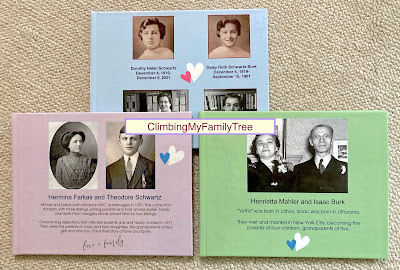On this day in 1911, my immigrant maternal grandparents got married on the Lower East Side of Manhattan. Hermina "Minnie" Farkas (1886-1964) and Theodore "Teddy" Schwartz (1887-1965) were born in different towns in Hungary, and both arrived at Ellis Island in 1901 when they were just teenagers. The path to their wedding wasn't smooth, since Minnie's parents weren't crazy about Teddy at first. But over time, she won them over.
That's the lede, and I didn't bury it. In fact, I put it front and center on the cover of my colorful family history photo book, to get readers intrigued by previewing the lives of these ancestors. This is my approach, which fits with my goal of making family history accessible and maybe even fascinating for younger audiences. Your approach might be different, of course, depending on your audience and your goals.
Inside the book, I wrote that my grandparents were married for 52 years, working side by side for much of that time in Teddy's Dairy grocery store in the Bronx, New York. I put in pictures of big family get-togethers (captioned) and mentioned their charitable works. Also, I traced their parents' histories, from birthplaces to marriage to burial places, and summarized what happened to their siblings. Finally, I talked just a bit about their descendants (my readers) and included some contemporary photos. My readers will, I hope, open the book in the decades to come and smile at what will by then be quote old family photos unquote ;)
No matter how you tell your family's story, I think it helps to cater to the interests and preferences of your audience--today and tomorrow.


















